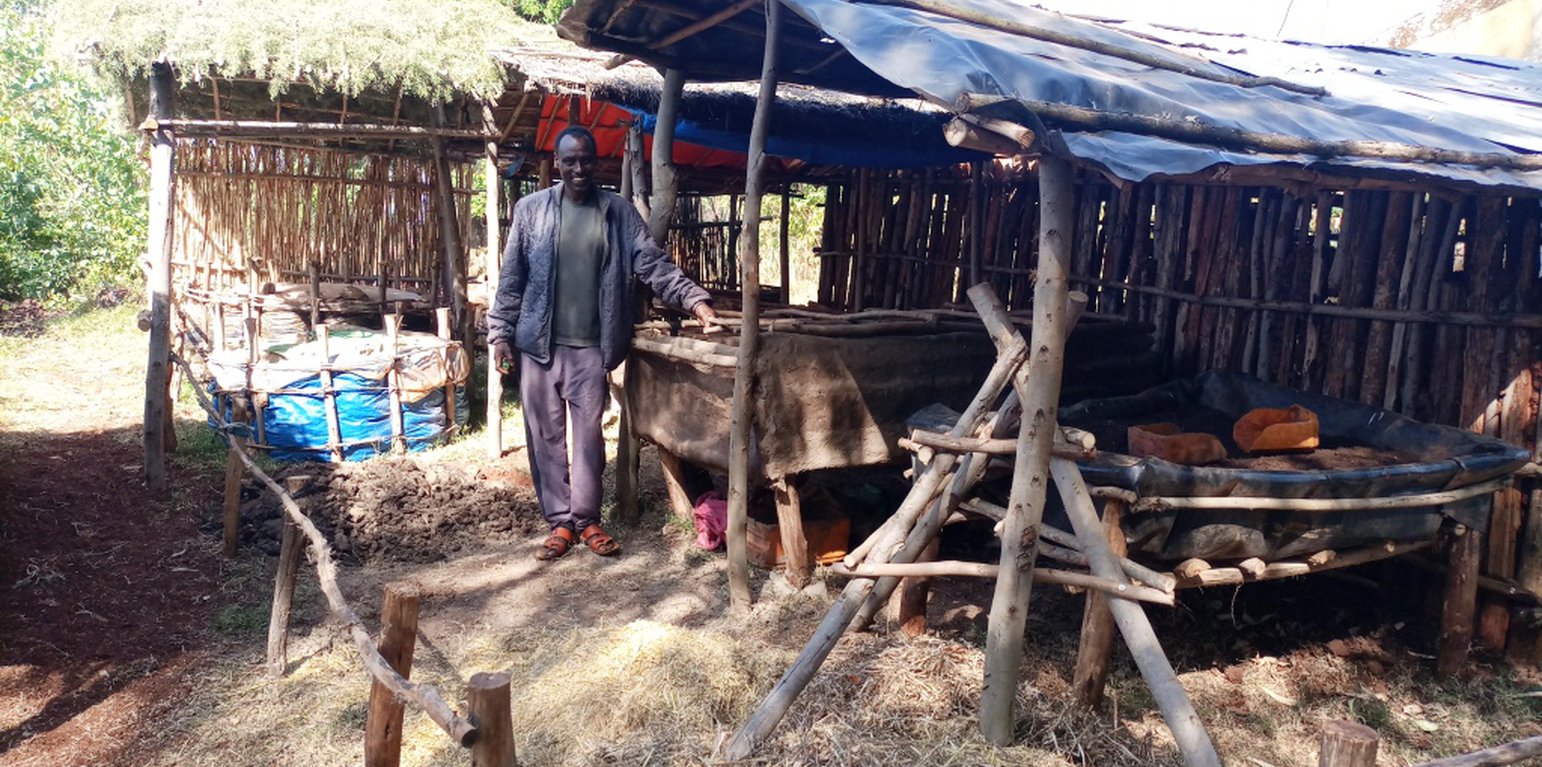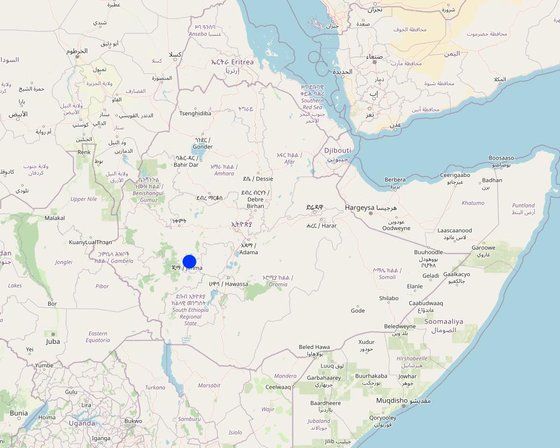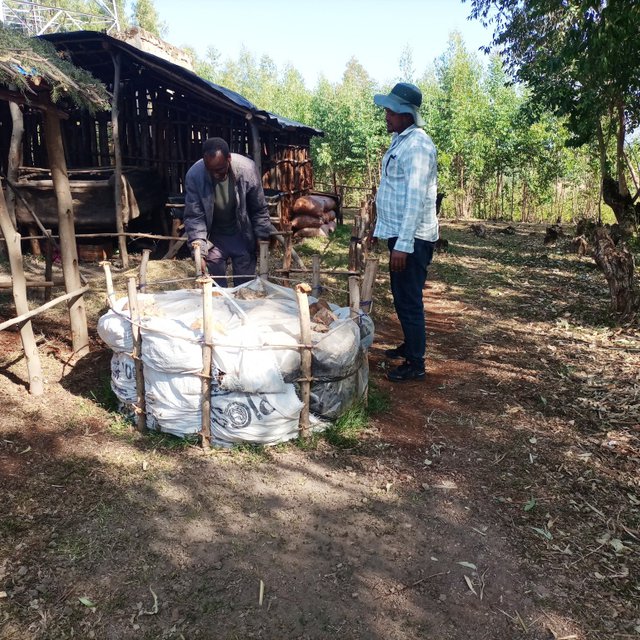



Improved composting using static pile systems transforms organic material from plants and/or animals into high-value, rich organic compost. This compost can be prepared in a heap form, where the ingredients are thoroughly mixed and wrapped within a polyethylene sheet. Notably, white polyethylene has the role of intercepting sunlight and improving the solarization effects on weed seeds or wild species arbitrarily used as biomass for improved compost production. This technique accelerates the breakdown of the organic materials faster because it heats up the compost as part of the decomposition process. Accordingly, the compost reaches maturity in 60-70 days. Compost provides the crop with balanced nutrients and helps to increase the soil's organic matter content. It has long‐term, and short‐term effects on plant nutrition as nutrients are continuously released. It is an organic matter resource with the unique ability to improve soils' chemical, physical and biological properties. Improved compost is applied in rows for vegetables and small cereal crops but spot application (planting holes) is employed for large cereal crops such as maize. The application is on an incremental basis year and again to reach out to the large size of lands. In principle, as the nutrients are slowly released, they may not need a continuous application like chemical fertilizers.
Improved compost-making requires 12-15 wooden pegs 1m high each supported by horizontal bars/string, to form a round structure. The interior is lined with plastic sheeting, then thoroughly mixed ingredients, including coffee hulls, ash, livestock manure, crop residues, livestock urine, water, and chaff are mixed and piled before being sealed in the structure. Unlike the mainstream heaps or pits types of composting, it doesn’t need turning. Therefore, this technique reduces labour requirement, and is liked by the users who have been piloting the technology. The relatively short maturity date also enables it to be produced at least twice a year during the offseason. Compost is prepared around the homestead – which allows closer attention - using livestock urine, manure, and house refuse.
In most of Ethiopia's central and western highlands, soil degradation is a severe issue. Soil acidity has become a growing problem challenging the livelihoods of smallholders. Thus, countering the negative effect of degradation and acidity through producing and using organic fertilizers is a key strategy. However, it is essential that the resources of biomass, family labour, skills and motivation, are combined to ensure sustainable land for crop production. From end users' observations and analysis, improved compost restores soil fertility. It increases yield as well as grain quality: this has been proved by testing the grain compared with the harvest where only chemical fertilizers have been applied. Farmers prefer the simplicity of preparing improved compost to the conventional method, and appreciate its role in improving yield and grain quality as well as reducing the labour demand.

ສະຖານທີ່: Babo kebele of Kersa district, Jimma zone, Oromia, ອີທິໂອເປຍ
ຈໍານວນ ພື້ນທີ່ ທີ່ໃຊ້ ເຕັກໂນໂລຢີ ທີ່ໄດ້ວິເຄາະ: 2-10 ພຶ້ນທີ່
ການແຜ່ກະຈາຍຂອງເຕັກໂນໂລຢີ: ນໍາໃຊ້ໃນຈຸດສະເພາະ / ແນໃສ່ນໍາໃຊ້ໃນພື້ນທີ່ຂະໜາດນ້ອຍ
ຢູ່ໃນເຂດປ່າສະຫງວນທີ່ບໍ?: ບໍ່ແມ່ນ
ວັນທີຂອງການປະຕິບັດ: 2022
ປະເພດຂອງການນໍາສະເໜີ








| ລະບຸ ປັດໃຈ ນໍາເຂົ້າ ໃນການຜະລີດ | ຫົວໜ່ວຍ | ປະລິມານ | ຕົ້ນທຶນ ຕໍ່ຫົວໜ່ວຍ (ETB) | ຕົ້ນທຶນທັງໝົດ ຂອງປັດໃຈຂາເຂົ້າ ໃນການຜະລິດ (ETB) | % ຂອງຕົ້ນທຶນທັງໝົດ ທີ່ຜູ້ນໍາໃຊ້ທີ່ດິນ ໃຊ້ຈ່າຍເອງ |
| ແຮງງານ | |||||
| Labor | PDs | 5.0 | 100.0 | 500.0 | 100.0 |
| ອຸປະກອນ | |||||
| Spade | number | 1.0 | 300.0 | 300.0 | |
| Reck | number | 1.0 | 160.0 | 160.0 | 100.0 |
| Machete | number | 1.0 | 1000.0 | 1000.0 | 100.0 |
| Sickle | number | 1.0 | 500.0 | 500.0 | 100.0 |
| ວັດສະດຸກໍ່ສ້າງ | |||||
| Posts for peg making | number | 2.0 | 50.0 | 100.0 | 100.0 |
| Horizontal bars | number | 5.0 | 10.0 | 50.0 | 100.0 |
| Strings | meter | 12.0 | 10.0 | 120.0 | 100.0 |
| Polyethylene sheet | meter | 14.0 | 50.0 | 700.0 | 100.0 |
| ຕົ້ນທຶນທັງໝົດ ໃນການຈັດຕັ້ງປະຕິບັດ ເຕັກໂນໂລຢີ | 3'430.0 | ||||
| ຄ່າໃຊ້ຈ່າຍທັງໝົດ ສຳລັບການສ້າງຕັ້ງເຕັກໂນໂລຢີ ເປັນສະກຸນເງີນໂດລາ | 64.57 | ||||
| ລະບຸ ປັດໃຈ ນໍາເຂົ້າ ໃນການຜະລີດ | ຫົວໜ່ວຍ | ປະລິມານ | ຕົ້ນທຶນ ຕໍ່ຫົວໜ່ວຍ (ETB) | ຕົ້ນທຶນທັງໝົດ ຂອງປັດໃຈຂາເຂົ້າ ໃນການຜະລິດ (ETB) | % ຂອງຕົ້ນທຶນທັງໝົດ ທີ່ຜູ້ນໍາໃຊ້ທີ່ດິນ ໃຊ້ຈ່າຍເອງ |
| ແຮງງານ | |||||
| Labor | PDs | 5.0 | 100.0 | 500.0 | 100.0 |
| ວັດສະດຸກໍ່ສ້າງ | |||||
| Plastic sheet | meter | 14.0 | 50.0 | 700.0 | 100.0 |
| Posts | number | 2.0 | 50.0 | 100.0 | 100.0 |
| ຕົ້ນທຶນທັງໝົດ ທີ່ໃຊ້ໃນການບໍາລຸງຮັກສາ ເຕັກໂນໂລຢີ | 1'300.0 | ||||
| ຄ່າໃຊ້ຈ່າຍທັງໝົດ ສຳລັບການບົວລະບັດຮກສາເຕັກໂນໂລຢີ ເປັນສະກຸນເງີນໂດລາ | 24.47 | ||||
As the farmland is closer to all-weather roads and the district town, the farmer can easily access almost all of the facilities in the area.
ປະລິມານ ກ່ອນການຈັດຕັ້ງປະຕິບັດ ການຄຸ້ມຄອງ ທີ່ດິນແບບຍືນຍົງ: 2 tons/hectare
ປະລີມານ ຫຼັງການຈັດຕັ້ງປະຕິບັດ ການຄຸ້ມຄອງ ທີ່ດິນແບບຍືນຍົງ: 2.8 tons/hectare
Maize yield has immensely increased during the first harvest with compost as compared to the plot with NSP fertilizer at the rate of 100 kg/ha. As nutrients from organic fertilizers gradually available, it is expected to increase in the coming years.
Land users communicated the positive effects of using compost on grain size and overall quantity of production.
As biomass production is increasing, the part of crop residue that is used for livestock feed is also increasing.
Farmlands where improved compost applied increases soil aggregate stability as compared to the farmland where only chemical fertilizers is applied.
Using organic fertilizer (improved compost) reduces land users investment on chemical fertilizers.
It correlates with increasing production per unit of land.
The farmer also generate income from the sale of compost itself.
Convergent to food and nutrition security.
Farmer group formation is promoted for peer learning.
Ground cover contributes to filtering the downslope runoff and siltation.
The organic matter in the improved compost improve soil structure and simplify water drainage down in soil horizon.
Improved compost increase biomass production and soil cover.
Improved compost promotes soil aggregate stability.
Salinity is uncommon in the district.
Compost promotes the growth of wild species and/or promotes the succession of some lost species.
It increases surface and subsurface biomass production and sequester soil carbon.
Slightly increases as it improves the soil infiltration potential.
It positively associate with reduction of the runoff due to good ground cover.
Such impact can be achieved in the long-term.